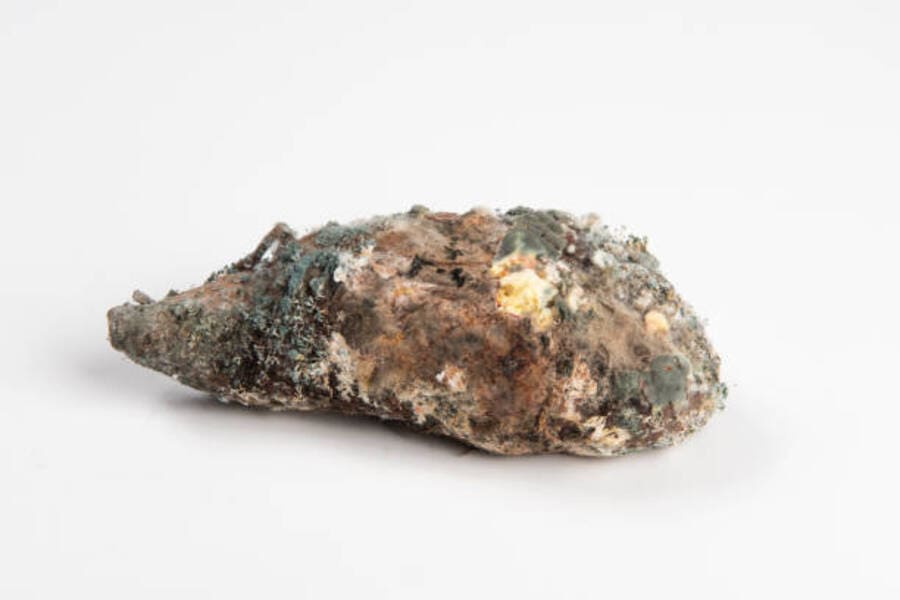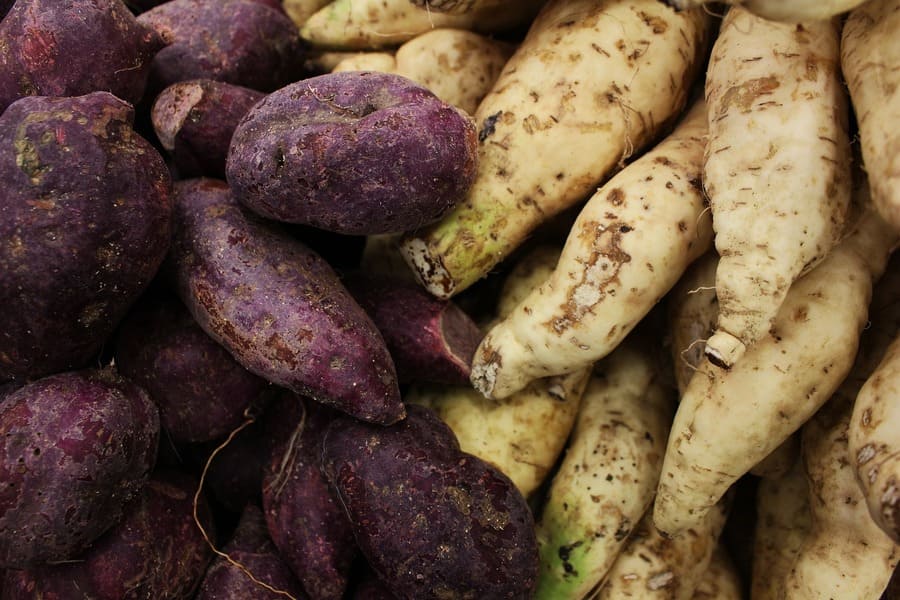Sweet potatoes are a delicious and nutritious addition to any meal, but what do you do if you’re not sure whether or not one is bad?
How to tell if a sweet potato is bad? In this blog post, we will discuss the signs that indicate a sweet potato has gone bad, as well as how to store sweet potatoes so that they last longer.
We will also provide some tips on how to use up any bad sweet potatoes you may have. So, keep reading.
How to tell if a sweet potato is bad?

Sweet potatoes are a nutritious and delicious addition to any meal, but they can go bad if they are not stored properly. There are a few key things to look for when checking if a sweet potato has gone bad.
- First, the skin should be smooth and bright in color. If the skin is shriveled or has brown spots, it is probably past its prime.
- The flesh of the sweet potato should also be firm to the touch; if it feels mushy or has dark spots, it has probably gone bad.
- Finally, if the sweet potato has a sour or musty smell, it is best to throw it out.
With these guidelines in mind, you can make sure that your sweet potatoes are always fresh and delicious. We hope now you know how to tell if a sweet potato is bad.
Can sweet potatoes go bad?
Yes, like all food, they can also go bad. Sweet potatoes should be stored in a cool, dry place, and they will keep for several weeks.
However, if they are stored for too long, they will begin to shrivel and develop brown spots. If sweet potatoes start to turn soft or develop mold, they should be discarded.
While it is possible to cook with some imperfections, it is generally best to err on the side of caution when it comes to food safety. Ultimately, if you are unsure whether or not a sweet potato has gone bad, it is best to throw it out.
How Long Does Sweet Potatoes Last?
Sweet potatoes will usually last for about two weeks in the refrigerator. If you want to store them for a longer period of time, you can place them in a cool, dark place like a basement or cellar. They should last for about two months under these conditions.
How long do sweet potatoes last in the fridge?
Sweet potatoes will last in the fridge for around two weeks. However, they are best eaten sooner than that for maximum freshness.
How long do sweet potatoes last in the pantry?
It depends on how they’re stored. If they’re stored in a cool, dark place, they can last for up to two months. However, if they’re stored in the fridge, they can last for up to four months.
How long do cooked sweet potatoes last?
If stored in a cool, dry place, cooked sweet potatoes will last for about 3-5 days. If you have any leftovers, you can store them in the fridge for up to 2 days. To reheat, place them in a microwave-safe container and heat until warm. You can also reheat them in the oven or on the stovetop.
How To Choose Good Sweet Potatoes?
When choosing sweet potatoes, look for firm, evenly-sized tubers with smooth, unblemished skin. Avoid any potatoes that are cracked, bruised, or otherwise damaged. The color of the skin is not necessarily an indicator of quality, so choose sweet potatoes based on other factors such as size and condition.
Signs that Sweet Potatoes Have Gone Bad

There are a few telltale signs that sweet potatoes have gone bad.
- They may develop a wrinkled or leathery skin, and the flesh may start to ooze a clear liquid.
- The flesh may also change color, appearing gray, blue, or green.
- Finally, sweet potatoes that have gone bad will often emit a foul odor.
If you notice any of these signs, it is best to throw out the sweet potato and purchase fresh ones. We hope now you know how to tell if a sweet potato is bad.
With proper care, sweet potatoes can last for several weeks. However, if they are not stored correctly, they will go bad quickly. As a result, it is important to check for signs of spoilage before eating sweet potatoes.
How to tell if sweet potato is bad inside?
The best way to tell if a sweet potato is bad inside is to look at the surface. If it has any signs of mold, bruising, or discoloration, then it is likely bad and should not be eaten.
Additionally, if the sweet potato feels soft or spongy when you poke it, then it is likely rotten and should not be eaten. If in doubt, throw it out. There’s no need to take a risk with food poisoning.
What about dark spots on sweet potatoes?
Sweet potatoes with dark spots on them may not be safe to eat. The dark spots are likely caused by a fungus, and the fungus may produce toxins that can make you sick.
If you see sweet potatoes with dark spots on them at the store, don’t buy them. If you have sweet potatoes with dark spots at home, throw them away. Now you know how to tell if a sweet potato is bad so don’t eat them.
What is the white stuff when you cut into a sweet potato?
The white stuff is the edible part of the sweet potato. It’s called the “pith” or the “meat.” The skin is generally not eaten.
The pith (or meat) is generally white, but it can also be orange, yellow, or purple. It’s high in fiber and nutrients like vitamin A, vitamin C, and potassium.
How to tell if purple sweet potato is bad?
In general, you can tell if a vegetable is bad by looking at it and smelling it.
If the vegetable is discolored, has mold on it, or has an unpleasant smell, then it is likely bad and should not be eaten. With purple sweet potatoes specifically, there are a few things to look out for.
- First of all, make sure that the potatoes are actually purple and not just a dark brown color.
- Secondly, make sure that there are no bruises or other signs of damage on the potatoes.
- Finally, make sure that the potatoes do not have a strong smell. If they do smell strongly of ammonia or some other unpleasant odor, then they are likely bad and should not be eaten.
How to store sweet potatoes?

While sweet potatoes can be stored like other potatoes, there are a few things to keep in mind to ensure that they stay fresh.
- First, sweet potatoes should be stored in a cool, dry place. A pantry or cupboard away from the oven is ideal.
- Second, sweet potatoes should not be stored in the fridge, as this can cause them to become mushy.
- Finally, it is important to check on the sweet potatoes regularly, as they can spoil quickly if not eaten in a timely manner.
When stored properly, sweet potatoes can last for several weeks. By following these simple tips, you can enjoy fresh sweet potatoes all season long.
Can you freeze sweet potatoes?
While most people know that you can freeze regular potatoes, you might wonder if you can freeze sweet potatoes. The answer is yes! Freezing sweet potatoes is a great way to extend their shelf life and enjoy them all year round.
To freeze sweet potatoes, simply wash them thoroughly, slice them into pieces, and place them in a freezer-safe container. You can also blanch them before freezing to help preserve their flavor and texture.
Tips about how to use sprouted sweet potatoes?
One way to enjoy sweet potatoes is to sprout them. Sweet potato sprouts are easy to grow and can be used in a number of different dishes. Here are some tips on how to use sprouted sweet potatoes:
- Add them to salads for a crunchy texture and additional nutrition.
- Use them as a topping on soups or stews.
- Mix them into smoothies or juices.
- Stir-fry them with other vegetables.
- Roast them in the oven for a crispy snack.
Whatever way you choose to enjoy them, sprouted sweet potatoes are a delicious and nutritious addition to any meal!
FAQs
Though sweet potatoes are often lauded as a healthy alternative to other starchy vegetables, they do have some potential drawbacks.
For one, sweet potatoes are a significant source of sugar. In fact, a single sweet potato can contain more than twice the amount of sugar as a regular potato.
This high sugar content can cause blood sugar levels to spike, which is particularly harmful for people with diabetes.
Moreover, sweet potatoes are also very high in carbohydrates, which can lead to weight gain if they’re consumed in excess.
Finally, sweet potatoes are rich in oxalates, which are compounds that can increase the risk of kidney stones.
Though sweet potatoes offer some health benefits, it’s important to be aware of their potential downsides before adding them to your diet.
Now, if you see a sweet potato somewhere, you’d know how to tell if a sweet potato is bad. Let’s discuss some frequently asked questions about it.
Like any food, sweet potatoes can potentially cause food poisoning. The most common symptom of food poisoning is gastrointestinal distress, including nausea, vomiting, and diarrhea.
Sweet potatoes can cause food poisoning if they are contaminated with bacteria, such as Salmonella or E. coli.
These bacteria can occur naturally on the surface of the potato or be introduced during food processing.
It is important to wash sweet potatoes thoroughly before eating them, and to cook them completely to kill any harmful bacteria.
Overall, sweet potatoes are safe to eat when properly prepared, but they can pose a risk of food poisoning if they are not handled properly.
Botulism is a potentially fatal form of food poisoning that is caused by a toxin produced by the bacterium Clostridium botulinum.
The toxin can affect both humans and animals, and it can be found in soil, dust, and water. While botulism is most often associated with canned foods, it can also occur in fresh foods, such as sweet potatoes.
When sweet potatoes are contaminated with the toxin, they may appear to be cooked properly, but they can still cause illness. Symptoms of botulism include nausea, vomiting, muscle weakness, and paralysis.
If you think you may have eaten a contaminated sweet potato, it is important to seek medical attention immediately.
Botulism can be treated with antitoxin, but it must be administered soon after symptoms appear in order to be effective.
Cutting mold off sweet potato is perfectly safe to do as long as you ensure that you remove all of the moldy parts. Once you have cut away the mold, make sure to cook the sweet potato thoroughly before eating it.
Mold can cause serious health problems if it is ingested, so it is important to take precautions when preparing food.
If you are unsure whether or not you have cut away all of the mold, it is best to discard the sweet potato and start again with a new one.
By taking these simple precautions, you can enjoy mold-free sweet potatoes without putting your health at risk.
Maybe you’d like to read:
- How Long Does Potato Salad Last In The Fridge?
- How long does Potato Soup last in the Fridge?
- 8 Substitute For Plum Tomatoes
- How Long Does Salad Last In The Fridge?

Welcome to my food site, RecipesAndPanty.com. I am a man who enjoys creating recipes and researching everything about food. This blog is dedicated to my grandmother because she gave me a taste for cooking.